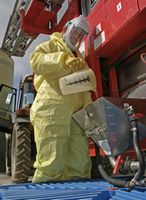Sprays price rises relatively small

Spray chemical price hikes this autumn should easily be offset by higher grain prices, industry sources suggest.
Glyphosate herbicide and cypermethrin insecticide are more expensive than a year ago, but other pesticides are only marginally so and some are cheaper.
Producers and distributors are keen to share in arable farmers’ revived fortunes, but generic products and seller competition should keep the lid on most potential increases.
Manufacturers are under pressure to recover more of the huge sums spent developing new products, several commentators noted.
“Inevitably we, as distributors, have to pass on any increases,” said Masstock’s Peter Corbett. “But there’s still plenty of competition to dampen any potential prices increases.
“I’d say that for budgeting, you should assume costs will be much as last year with a little bit added for inflation.”
Glyphosate is more costly because world demand, largely driven by GM crops, has outpaced production capacity and China has modified its export taxes regime. Re-registration accounts for cypermethrin’s increased price tag, said Mr Corbett.
 The temptation to trim chemical doses too far should be eased this autumn. |
“While IPU and trifluralin are around as cost-effective options, they will help hold prices,” he said. “There is still enough competition out there so that unless there is a concerted effort from all manufacturers, nothing will change.”
Branded products are rising, averaging 4%, said TAG’s David Parish. “But that’s not consistent across all products.
“It is only a bit over the rate of inflation, so it’s not unreasonable,“ he added.
Several manufacturers vying for a share of the pre-em cereal herbicide market should ensure any increases are modest.
The picture could change when it comes to the post-em market, Mr Parishsuggested. “The one that will be interesting to watch will be Atlantis.”
In theory, distributors who bought IPU products and trifluralin before grain prices rose could charge more for them, especially if the cereal area increases on expectations of zeroset-aside.
“They are only produced to order,” saidAgrovista’s James MacWilliam. “So supplies could become tight.”
Slug pellets could also become pricier as manufacturers had to buy in fresh supplies of wheat, he added.
If stocks of key products become low, price is less relevant in purchasing decisions, noted Lincolnshire–based business consultant Philip Wynn.
“You have to remember that production runs were planned some time ago for many key products,“ he pointed out.
Although farmers should be more able to absorb stiffer prices, the NFU’s Paul Chambers stressed that more wheat was sold forward this year in reaction to better prices. “Very few will have sold at the top of the market.”
| Pesticide price trends |
|---|
Compared with same time last year: Brands
Generics
Source: TAG |
| No comment |
|---|
|

